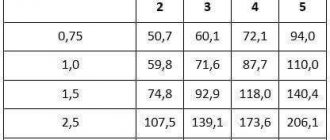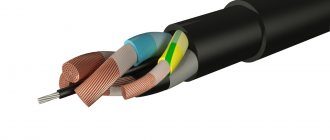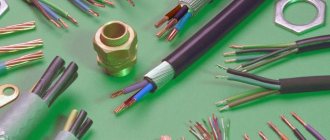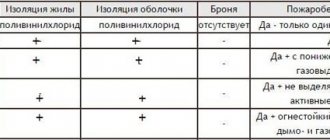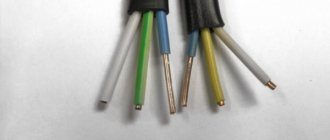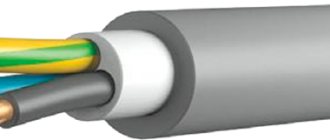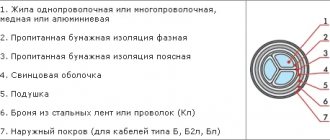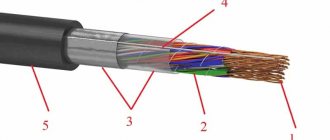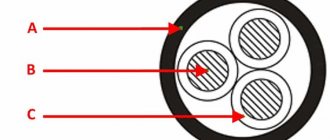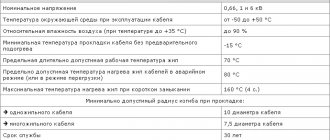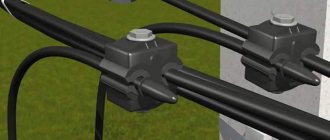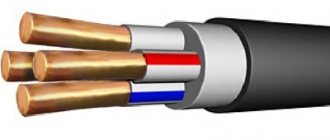Types of electrical wires and their purpose
Wires can be:
- Aluminum
- Copper
Currently, preference is given to wire with copper cores. The resistance of this metal is much lower than that of aluminum. Accordingly, with the same cross-section, a copper cord is able to pass more current and, therefore, provide more power. In addition, copper wire lasts longer.
However, aluminum is cheaper than copper, so not so long ago aluminum wiring was installed everywhere. And now those who want to save money and are not very concerned about security use it. In addition to the metal of the conductor, electrical cables are divided into:
- Single-core. Rigid and not flexible, they are good for hidden wiring of a simple configuration. They do not need to be changed often, they are quite reliable and durable.
- Stranded. Soft, designed to withstand constant bending. Very flexible, they are suitable for electrical cords of any household appliances, extension cords, and carriers. This type of power cord is used for open-type electrical wiring. The safety requirement for such wires is double insulation. That is, each core is insulated separately, and then enclosed in a common shell.
IMPORTANT! You cannot connect wires of different metals by simple twisting. If you need to use both copper and aluminum wire, make the connection only through the terminal block. Otherwise, the galvanic couple formed by direct twisting will oxidize and either overheat or lose contact.
The best solution would be to make electrical wiring from identical cables - either only copper or only aluminum.
Core material
For the manufacture of cores, different types of raw materials are used (alloys of aluminum, copper, steel). Combined compositions and synthetic core materials are acceptable. To transmit optical signals, the wires are made of plastic or glass. Nichrome cores are used to dissipate thermal energy.
Copper
Copper cores, in accordance with manufacturing technology, are produced either ductile or rigid. The diameter of single-wire elements is 16-95 mm², multi-wire - 25-800 mm². Cores with a rigid structure have a round cross-section. Copper alloys are effective, reliable, durable, but have a high price.
For hidden wiring: technical specifications
From the marking of a wire or cable, you can immediately understand its characteristics. The letters in the abbreviation indicate the materials from which it is made, the numbers indicate the number of cores and cross-section. Abbreviations like AVVG or VVG are markings for an unarmored wire or cable, or, as the experts say, “naked.” The letter A indicates that the wire is aluminum. If it is missing, then the wire is copper.
For hidden wiring in standard dry premises for residential or office purposes, the following are most often used:
- AVVG - flat or round with an aluminum single-core conductor. There are from 1 to 4 cores in a cable or wire. Non-flammable
- VVG is a flat or round cord with a single-core copper conductor. An electrical cable or wire can have from 1 to 4 cores. There is a non-flammable modification VVGng and a non-flammable modification with reduced smoke emission VVGng-LS.
- PVA - round wire with copper stranded conductors
- ShVVP is a flat wire with stranded copper conductors. It has a small cross-section - 0.75 mm2 maximum. Used when connecting household electrical appliances.
- Or imported NYM - analogue of VVGng. It only happens to be round.
Power cables
A powerful cable for power lines is a single-core or multi-core electrical product designed to supply electrical energy to stationary consumers, such as a private house, apartment, cottage or mobile equipment. The power cable connects the main distribution panel or power line to the end user. Regardless of the area of use and technical characteristics, its design consists of the following mandatory elements, which are its basis:
- one or more metal conductors designed to transmit current;
- an insulating layer that provides protection for conductive elements;
- outer sheath, which serves to protect the entire cable structure as a whole.
In addition to these main structural parts of power cable products, they can include a variety of additional elements, such as external belt insulation, a shielding layer, and armor with a cushion under it. The design of the power cable depends on its purpose, scope of use and operating conditions. All these factors are reflected in the color markings and names of the products.
Important! When choosing a power cable, it is necessary to take into account many factors: operating conditions, type and type of installation, as well as compliance with PES standards. This is due to the fact that different brands of cable products have both advantages and disadvantages that must be taken into account when purchasing.
Power cable - marking features
The properties and design features of power cables, as well as the scope of application, are determined by the marking of cable products. Today, there are two types of marking of such products: color or letters. In the Russian Federation, the alphabetic one is used, where each character and its location has a specific meaning. The first character indicates the material of the core and if it is “A”, then it is made of aluminum, and if there is no letter, then it is made of copper. The table below shows the order of marking signs, their letter designation and interpretation.
| Sign number in the power cable marking | Purpose of the symbol | Decoding the symbol |
| 1 | Current-carrying material | A - aluminum No sign - copper |
| 2 | Insulating layer material | B - polyvinyl chloride C - impregnated paper HP - non-flammable rubber P - thermoplastic polyethylene |
| 3 | Type of outer sheath | C - lead alloy A - aluminum alloy O - separate sheath for each core P - polyethylene or polymer B - polyvinyl chloride |
| 4 | Armor protection | B - two steel strips with coating Bn - the same with a non-flammable coating BbG - profiled steel strip K - round galvanized wire P - the same with flat wire |
| 5 | Shielding | E - copper along an insulated conductor Eo - common copper for three conductors d - water-swelling tape ha - polymer-aluminum tape |
| 6 | additional characteristics | ng - off ng LS - off, low smoke emission G - flexible cable |
If any of the elements are missing from the marking, it means that it simply is not on the power cable. Let's say you don't see the armor designation, which means it's missing. The presented letter marking is relevant not only for power cables, but also for other types of wires, with minor changes and additions. Below we will look at the main and most popular brands of power cables produced by the electrical industry.
VVG cable
The main purpose of the VVG power cable is the electrification of facilities with a network voltage of up to 1 thousand volts. This brand is especially popular for indoor electrical wiring. If you refer to the marking table presented above, then VVG is a copper cable with core insulation made of polyvinyl chloride and external insulation in the form of a cambric made of the same material, and the letter “G” indicates that it is flexible. The number of cores of the product can be from two to five. The service life of these products can reach over 30 years.
The VVG power cable is produced in different versions: AVVG - with current-carrying conductors made of pure aluminum, VVGng - in a protective casing made of fire-resistant material, VVGp - a flat-type product and others. The color of the external insulation for most products is black, and each core has its own color scheme, corresponding to the marking according to the standard: yellow with a green stripe for PE conductors, blue or white with a blue stripe for N cores, and absolutely white for phase cores. The VVG power cable almost completely corresponds to its imported analogue, produced according to the foreign DIN standard, the technical parameters of which are presented in the following section.
NYM cable
NYM power cable is used for installation work when laying lighting networks and power electrical networks in both residential and industrial premises. The maximum voltage at which this product can be used should not exceed 660 volts. The cable can be used in open spaces, but it should be taken into account that its insulation is subject to destruction under the influence of sunlight. Therefore, the NYM cable must be protected with a special corrugation or other protective sheath. The main feature of this product is that it is equipped with a special filler inside the outer shell, which ensures complete sealing of the cores.
Unlike the domestically developed VVG power cable, NYM wire is produced only in a round version with solid copper conductors. This fact gives it an advantage in conventional electrical installation, but it is very inconvenient to install it in hidden wiring grooves. In all other respects, the NYM cable is a complete analogue of the VVG. The external and internal insulation of the product is made of heat-resistant PVC (polyvinyl chloride). Its color for the outer sheath is mainly black, and the insulation of the current-carrying conductors has the following colors: black, yellow with a green stripe, brown, as well as gray and blue. In Russian, the product does not have a letter designation.
SIP cable
A SIP power cable is a self-supporting electrical wire with reliable core insulation, the very name of which speaks of its specific properties. Its main feature is that it can withstand large mechanical loads. In addition, the insulating layer of the product is made of stitched polyethylene, which withstands exposure to sunlight and high humidity. Based on these properties, SIP is excellent for installing power lines in open spaces and branches from them for the electrification of various objects, such as residential, as well as small industrial and commercial. This type of cable products is gradually displacing from the market aluminum wires without insulation of grades “A” and “AC”, which were widely used for laying overhead power lines in the recent past.
SIP cable is produced only with cores made of pure aluminum, which do not have an additional common insulating layer. The cross-sectional area of the product conductors can be from 16 to 150 square meters. mm. The marking of this cable is not directly related to the number of current-carrying wires. For example, SIP-1 is a three-core cable, the zero current-carrying conductor of which is also load-bearing. The designated product number encrypts all information about the product. SIP power cable is a rather specific cable product. When installing it, it is necessary to use special fittings: specialized anchor brackets, special clamps for connection, and so on. Without these additional elements it is impossible to carry out installation work.
Cable VBBShv
This product refers to power cables with armor and current-carrying conductors made of copper, which are produced in both monolithic and stranded versions. The cable design can consist of from 1 to 6 current-carrying cores, each of which is enclosed in its own PVC insulation, and on top they are covered with a common sheath of the same material. The cross-sectional area of the conductors ranges from 1.5 to 240 square meters. mm. The main feature of VBBShv is the presence of an armor layer made of two steel strips between the outer protective shell and the current-carrying conductors.
This cable is designed for operation in a wide temperature range from –50 to +50 °C and ambient humidity up to 98%. The insulation of the product is resistant to moisture and aggressive environments. Armored cable VBBShv is intended for installation of electrical networks both underground and outdoors in protective sheaths to eliminate the negative effects of sunlight. VBBShv can be operated in networks with a maximum AC voltage of up to 6 thousand volts.
Attention! At the top of the article, we looked at the most common types of power cables that are present on the modern market. In addition to these products, for the full installation of electrical networks it is necessary to use another type of electrical products, which can be called electrical wires, although this is a purely conditional division. Below we will look at non-power cables, wires and cords intended for electrical wiring and other purposes.
For outdoor installation
Underground supply to the building is made only with the help of armored electrical cables AVBBSHV or VBBSHV. The steel armor tape on such electrical cables passes over the second insulating layer and has its own protection - a rubber coating. Such protection of current-carrying elements from groundwater and mechanical influences ensures the durability and reliability of the electrical supply.
For installation of external electrical wiring on street-side walls or roofs, the optimal types of wires/cables are AVVG or VVG. These brands have excellent insulation that can withstand low and high temperatures and ultraviolet radiation.
Screens, fillers and shells
The design of a power cable includes the required layers between the insulation:
- screens;
- fillers;
- shells;
- protective coatings.
Screens are designed to protect outer layers from electromagnetic influence. The elements are made of foil and paper treated with a special compound.
Fillers are made in the form of bundles of plastic, rubber, and paper tapes. The elements allow you to adjust the tightness of the junction of parts of the structure. The compositions make the product airtight, resistant to mechanical stress, and give it the required shape.
Sheaths are designed to protect the surfaces of the wire. Parts of the structure are made of alloys of aluminum, lead, non-flammable plastic and rubber. Surfaces can be smooth or corrugated. Sheaths prevent deformation of the wire from the action of water and acid-base compounds.
The final components of the design are protective covers (cushion, armored cover). Armor made of galvanized strips and wires gives the product strength.
In rooms with high humidity
In rooms with high humidity For rooms with high humidity - baths, sheds, basements and other outbuildings, special electrical wiring is required. This especially applies to objects where not only humidity, but also temperature is increased. It is best to use heat-resistant electrical cables with silicone protective insulation of the PVKV or RKGM brands.
IMPORTANT! When installing electrical wiring in damp rooms, do not forget to take care of grounding the wiring itself and all electrical appliances.
Types of installation wires
The following types are suitable for installation work:
- RKGM is a heat-resistant copper cable that can withstand up to 660 V and up to 400 Hz. The rubber insulation is covered with fiberglass impregnated with varnish. Can operate at -60…+180 °C.
- PNSV - core made of galvanized or blued steel, the insulation is heat-resistant, retains its properties at -50...+80 °C. Provides voltage transmission up to 380 V, is resistant to the negative effects of alkali and even withstands immersion in water.
- VPP - copper stranded conductor, double PVC and polyethylene insulation. Designed to operate in networks up to 380 V, withstands large pressure drops and temperatures -40...+80 °C. Such cables are suitable for connecting an electric motor immersed in an artesian well.
Dimensions and calculation of the cross-section of aluminum and copper
This is the most important point when choosing the right electrical cable. To make an accurate calculation you need to take a few simple steps:
- Calculate the total power of all electrical appliances in the home. This figure will allow you to determine the characteristics of the electric main running from the support to the house.
- Calculate the total power of devices for each room. This allows you to select the desired cross-section of wire that will be laid in each room.
- Route the incoming cable to the VU (ASU) and use the machines to make a wiring diagram for the rooms, taking into account the wire cross-section for each room separately. The cable cross-section based on power is calculated using a special table, which can be found in any electrical reference book. When making calculations, round up and add 20-25% margin. So, for example, a cable with a diameter of about 1.8 mm (section 2.5 mm) will withstand:
- Copper: 21 amps (4.6 kW at 220V)
- Aluminum: 16 amps (3.5 kW at 220V)
This difference clearly shows the advantage of copper electrical cable over aluminum.
Life time
The cable service life is regulated by state standards (GOST 16442-80, GOST 18410-73, etc.), divided into actual and warranty.
The product warranty is issued by the manufacturer for a period calculated from the start of use of the design. The procedure is valid if the buyer complies with the rules of transportation, installation, and operation. The warranty on wires with plastic insulation is at least 5 years. Cables with paper insulation are guaranteed for up to 4.5 years.
The cable shelf life represents the actual period of use of the structure up to the technical parameters permitted by the standard. The actual duration and period of operation for cables with plastic insulation is about 25 years. Wires insulated with impregnated paper can be used for up to 30 years.
Choosing what to prioritize when purchasing
The choice of the right brand of wire or cable is determined only by the decision of the electrician. The main requirement is an exact correspondence of the cross-section of the potentially consumed power. When choosing equipment for open-type wiring, the color of the wire can play an important role. If you plan to install wires using cable ducts, it is worth remembering the type and standard color of cable insulation depending on the brand:
- ShVVP - white or black
- VVG - black
- PVA – orange, white
- NYM - gray
When purchasing, be sure to pay attention to all the inscriptions that indicate:
- GOST standards
- THAT
- manufacturer
- brand
There should be a tag on the bay containing all this data. In addition, along the entire length of the wire, right on the insulation, its brand and cross-section are indicated. If you do not find at least one of the items listed, you cannot buy such an energy cable.
There are several brands of cables that are prohibited for use due to fire hazard. This:
- PUNP
- PUNGP
- PUVP
- PBPP
Their cost compared to, say, VVG, is significantly lower, and only a specialist can distinguish a prohibited wire from a required one by appearance. Therefore, before purchasing, carefully check all markings on the coil and insulation of the electrical cable.
Some unscrupulous manufacturers reduce the cost, and therefore the selling price, by unauthorizedly reducing the cross-section of conductors and reducing the thickness of the wire insulation. Semi-underground factories also sell copper-clad aluminum cables under the guise of copper cables.
Therefore, before choosing and purchasing a wire or cable for your home, carefully check all manufacturer certificates and do not buy products from little-known companies.
Insulation in electrical wiring
The main task of the insulating layer in electrical wiring is to protect a person from contact with the above-mentioned conductors carrying current. In addition, thanks to insulation, several cores can be placed side by side: insulation avoids short circuits.
When choosing insulation, several parameters play a key role, namely:
- ability to withstand stress;
- temperature resistance;
- mechanical strength;
- UV resistance.
Insulation materials
Dielectrics can be glass and ceramic; for flexible wires and cables that are laid indoors, celluloid, polyvinyl chloride, rubber, polyethylene, carbolite and impregnated paper are used.
In domestic conditions (for example, for electrical wiring in apartments and houses), conventional polymer insulation is most often used, which protects the conductors from mechanical damage, humidity, external factors, but most importantly, from short circuits.
To lay lines under highways, on unstable soils and in other difficult conditions, armored cables and wires are used, which use multilayer insulation with steel tape or additional braiding. We will talk about additional insulating elements below.
Additional elements of external insulation
External insulation not only connects all components of the cable, but also protects the internal insulation from various factors: drying out, humidity, mechanical damage. For external insulation the following are used:
- Shielding
. It is used to protect against parasitic currents, as well as to equalize the electromagnetic field inside the wire itself. - Reservation
. Durable metal braid guarantees maximum protection against mechanical damage. - Cotton braid
impregnated with chemicals. Protects from rotting and mechanical damage. - Galvanized steel braid
. Protects against stretching.
Thus, additional protective elements are added to the external insulation depending on the purpose of the cable.
Advantages of copper conductors
It is not without reason that copper is chosen as a raw material for the manufacture of cable products. Compared to aluminum, it has a number of advantages:
- The resistance of copper wires is lower than that of aluminum. This allows the use of a smaller cross-sectional diameter and reduces heating losses.
- Good corrosion resistance. Complete replacement of supply networks is carried out after 30-35 years of operation.
- Plastic. Copper wire is very flexible, which makes the installation process easier and eliminates kinks.
Wire PBPP – PUNP
Copper flat wire: single-wire cores, 2 or 3 pieces, PVC insulation and sheath. It works normally if the atmosphere is -15°C to +50°C, humidity limit is 98%. Tolerates aggressive environments well. Black or white, blue or greenish veins.
They are good at installing lighting systems and wiring sockets in buildings, with a maximum of alternating current with an industrial frequency of 250 volts. The radius bends at a level not inferior to ten times the width. Delivery mode - coils of 100 and 200 meters. The modification of PBPPg (PUGNP) is of a multi-wire type, the bending radius is not less than 10 times the width. APUNP has solid wire, only the cores are made of aluminum.
